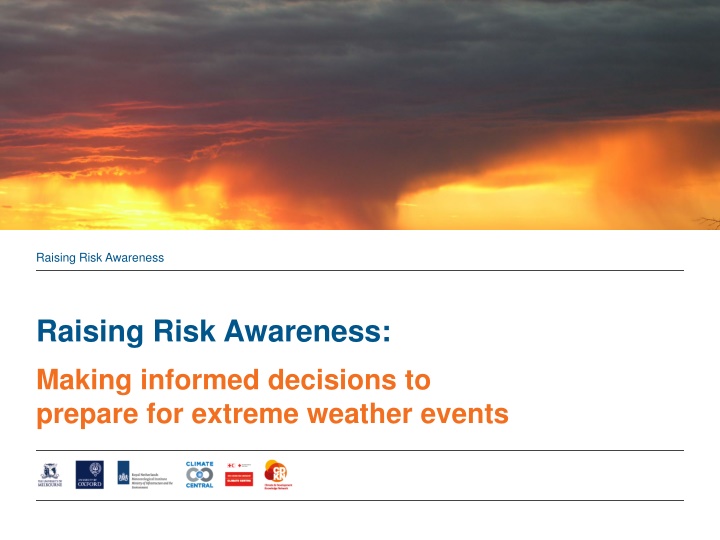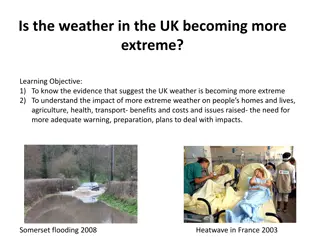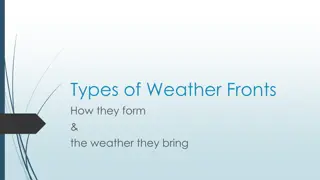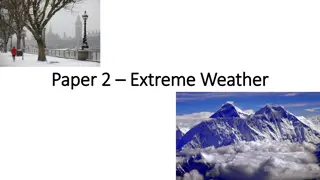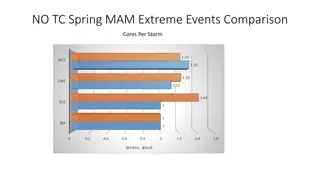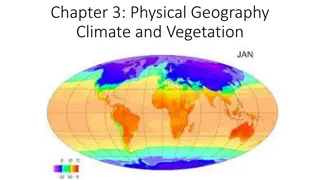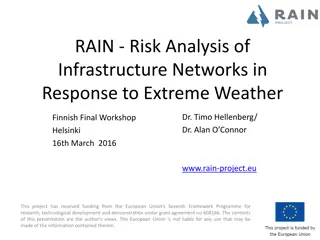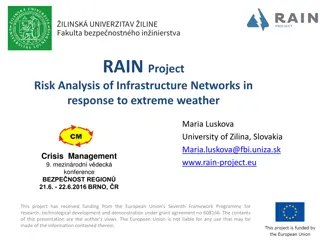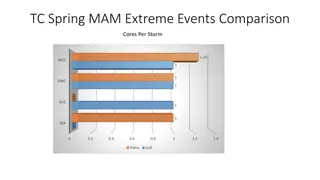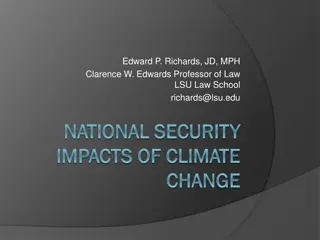Raising Risk Awareness: Understanding Extreme Weather Events
Raising Risk Awareness initiative focuses on attributing extreme weather events to climate change in Ethiopia, Kenya, India, and Bangladesh. Scientists and experts collaborate to assess risks, prioritize adaptation solutions, and reduce vulnerability by making informed decisions. By understanding the impact of climate change, we can better prepare for future extreme weather events.
Download Presentation

Please find below an Image/Link to download the presentation.
The content on the website is provided AS IS for your information and personal use only. It may not be sold, licensed, or shared on other websites without obtaining consent from the author.If you encounter any issues during the download, it is possible that the publisher has removed the file from their server.
You are allowed to download the files provided on this website for personal or commercial use, subject to the condition that they are used lawfully. All files are the property of their respective owners.
The content on the website is provided AS IS for your information and personal use only. It may not be sold, licensed, or shared on other websites without obtaining consent from the author.
E N D
Presentation Transcript
Raising Risk Awareness Raising Risk Awareness: Making informed decisions to prepare for extreme weather events
Raising Risk Awareness The Raising Risk Awareness initiative Raising Risk Awareness (RRA) brings together: scientists vulnerability experts knowledge brokers to assess the role of climate change in extreme weather events in Ethiopia, Kenya, India and Bangladesh to help prepare for future ones Making informed decisions to prepare for extreme weather events 2
Raising Risk Awareness The team The Raising Risk Awareness team includes the Climate and Development Knowledge Network (CDKN) and World Weather Attribution (WWA) partners: Climate Central Red Cross Red Crescent Climate Centre Royal Netherlands Meteorological Institute (KNMI) University of Melbourne University of Oxford India partner: The Indian Institute of Technology Delhi Making informed decisions to prepare for extreme weather events 3
Raising Risk Awareness Why do we seek to attribute extreme weather events? Attribution analyses allow scientists to make quantitative statements about whether climate change has altered the risk of extreme weather events occurring These analyses help decision makers and the public to prioritise adaptation solutions and reduce vulnerability Making informed decisions to prepare for extreme weather events 4
Raising Risk Awareness Global average temperatures do not kill people. What kills people are extreme weather events. This research allows us to get a more comprehensive picture of what climate change actually means [ ] and allows us to make better planning decisions. Friederike Otto, deputy director of the Environmental Change Institute at the University of Oxford Making informed decisions to prepare for extreme weather events 5
Raising Risk Awareness Section 1 How it works Making informed decisions to prepare for extreme weather events 6
Raising Risk Awareness 1. Extreme weather event An extreme weather event, such as a flood, drought or heat wave, occurs somewhere in the world Making informed decisions to prepare for extreme weather events 7
Raising Risk Awareness 2. Disaster response Governments, emergency responders and humanitarian actors respond to the event Making informed decisions to prepare for extreme weather events 8
Raising Risk Awareness 3. How do we build back better? Policy makers, humanitarian actors, engineers, community members and others are faced with decisions about how to rebuild and prepare for changing risks Making informed decisions to prepare for extreme weather events 9
Raising Risk Awareness 4. Is the past a good indicator of the future? Many actors wonder if they can use their experience and knowledge about past climate extremes and impacts as good indicators of future risk Making informed decisions to prepare for extreme weather events 10
Raising Risk Awareness 5. Determining the influence of climate change Climate scientists use multiple independent methods to determine whether and to what extent climate change is making some extreme events occur more often and with higher intensity Making informed decisions to prepare for extreme weather events 11
Raising Risk Awareness 6. Assessing the event Climate scientists conduct independent assessments using multiple peer-reviewed approaches of extreme event attribution methodologies, including statistical analyses of the historical precipitation record, the trend in global climate models, and the results of thousands of simulations of possible weather with a regional climate model Making informed decisions to prepare for extreme weather events 12
Raising Risk Awareness 7. Analysing the exposure and vulnerability context Social scientists examine the underlying exposure and vulnerability within the social, economic and political context of the event Making informed decisions to prepare for extreme weather events 13
Raising Risk Awareness 8. Experts communicate message Scientists inform the media about whether and to what extent climate change influenced the extreme event The media and other stakeholders then spread that information to decision makers and the public Making informed decisions to prepare for extreme weather events 14
Raising Risk Awareness 9. Better decisions People use this information to make better decisions on how to respond to, and build back from, an extreme weather event Making informed decisions to prepare for extreme weather events 15
Raising Risk Awareness 10. Improve resilience This information will help stakeholders prepare for the risk of future climate change- driven extreme events and ensure that communities, organisations and systems are resilient . Making informed decisions to prepare for extreme weather events 16
Raising Risk Awareness Get in touch Heather Lynch heather.v.lynch@pwc.com Suzanne Carter suzanne.carter@cdkn.org Making informed decisions to prepare for extreme weather events 17
Raising Risk Awareness Image credits Slide 7: Drought. Tim J Keegan/Flickr Slide 8: Managing flood risk. Asian Development Bank/Flickr Slide 11:Satellite image of tropical cyclone Mahasen in the Northern Indian Ocean. UWM-CIMSS/William Straka III/NASA/NOAA/Flickr Slide 14: Sourcing water in the Moyale zone, Ethiopia. Andrew Heavens/Flickr Slide 15: Building flood defenses, India. Asian Development Bank Slide 16: Weathering a microburst, Ethiopia. UNICEF Ethiopia/Flickr Slide 17: Aerial image of Ethiopia. NASA Johnson/Flickr Making informed decisions to prepare for extreme weather events 18
